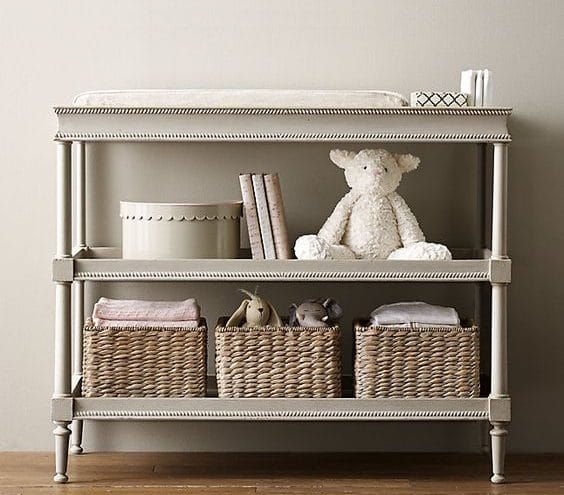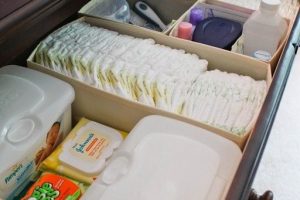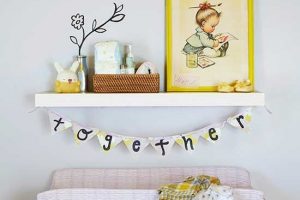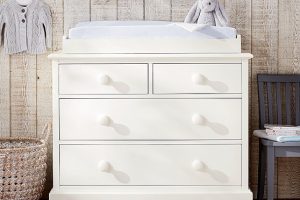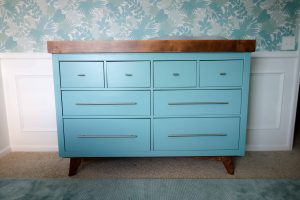Strictly speaking, a baby changing table is not really a baby-must-have. You could change your baby’s diaper wherever it is safe to do so. However, having a diaper changing table is really nice. After all, you’re going to be changing 2000+ diapers, so you might as well have a nice diaper changing station to do the dirty work in style.
Also, having a dedicated baby changing station is really convenient. You’re going to need supplies like diapers, wipes, diaper rash creams, a change of clothes, etc. Having those things neatly organized and within easy reach, is ideal!
Some parents also use their baby dresser as a changing table. While this is okay, do keep in mind that a dresser is not necessarily made to be a changing table, and therefore it does not have the safety features that a traditional changing table has, like raised safety railings. You will have to make a few modifications for your baby’s safety.
What You Need To Consider Before Buying A Baby Changing Table
-
What Is Your Budget?
There are tons of beautiful baby changing tables on the market, but they may not all fit your budget.
But you have options:
- You could invest in a large baby changing table dresser. These are traditionally more expensive, but they will last for years. You can easily convert it into a dresser for your toddler. or;
- You could spend much less money on a small but useful diaper changing table. Once your baby is potty trained or too tall to fit onto the baby changing table, you can donate it or find another use for it.
-
How Much Space Do You Have?
Will your baby be in your room initially, or do you have a baby nursery. If you have a nursery, is it big or small?
Your answers will depend on what kind of diaper changing table you will get. For smaller spaces, a compact changing table will be needed. They are comparatively cheaper than a changing table dresser, and you can donate it once your baby no longer needs it.
If you have the room and the budget, you may want to consider a larger changing table with drawers. They are versatile and they easily convert into a dresser for your toddler.
-
How Tall Are You?
You’re going to be changing 2000+ diapers at your baby changing station. If the height of your changing table is not in proportion to your height, you may end up with back pain.
Baby changing tables vary in height. You can find diaper changing stations as low as 36 inches or as high as 43 inches. If you are tall, get a baby dresser that is higher. If you are short, go for the lower changing table.
Whether you are buying your diaper changing table at a store or you are ordering online, do check the height. If you are in a store, bend over it as if you are about to change a diaper, and see if the height works for you. If you are ordering online, find a piece of furniture in your home that is of a similar height, and see if it works for you.
-
How Much Storage Do You Need?
Will you be using your diaper changing station to only change diapers,? If that’s the case, you will need storage for diapers and your other diaper changing essentials, which include baby wipes, diaper rash cream, a change of clothes, etc. However, if space is an issue for you, you’re likely to use your changing table like a typical baby dresser as well.
Many baby changing tables have open shelves that make it easy for you to reach your diapers and wipes. They can either be stacked in plain sight or arranged in decorative wicker baskets. Some diaper changing stations have drawers or a combination of drawers and shelves. Either way, it is always best practice to store your changing table essentials within your easy reach, but out of your baby’s reach. If not stored away, ointments and things can find their way into your baby’s mouth — or on the floor.
While shelves are great, having at least one drawer is ideal. A drawer has an advantage over open shelving because it can hide diaper supplies from a curious baby/ toddler.
Also keep in mind that your initial storage needs are going to change as your baby grows.
-
Does It Have Safety Barriers?
Traditional baby changing tables have 4 restraining barriers. These barriers are usually made of rails or wood sides.
For safety, changing tables with a flat changing surface must have a barrier on all sides of the changing surface, according to JPMA and ASTM safety standards. However, diaper changing tables with a contoured changing surface need only have barriers on two opposing sides to comply with safety standards.
For Safety:
- Regardless of whether your changing table has 2 barriers or 4, do keep a hand on your baby at all times during diaper changes;
- Always use the changing table or changing pad’s safety straps.
-
Does It Come With A Changing Pad And Safety Strap?
Many diaper changing tables come with a changing pad that affixes to the dresser /table with a safety strap. If yours does not come with a changing pad, you can buy it separately. However, do make sure that you buy a changing pad in a size the changing table manufacturer recommends. The dimensions of a standard changing pad is 17″ x 33″.
Safety Requirements For Your Baby Changing Station
You’ve picked a beautiful diaper changing table. It satisfies all your needs. Congratulations. Here’s what you need to do next:
Secure The Changing Table Or Baby Dresser To The Wall
All Furniture needs to be secured to the wall to prevent it from toppling over onto your baby/ toddler. This is easy to do with anchors and tethers.
Most changing tables come with the anchors and tethers to brace it in place. If it does not, Amazon ![]() or your local Walmart, Target, or hardware store will have the pieces you need.
or your local Walmart, Target, or hardware store will have the pieces you need.
Always Keep At Least One Hand On Your Baby
Baby changing pads come with security straps. However, you do need to always keep at least one hand on your baby, no matter what. Accidents happen quickly. This is why it’s good practice to keep all your diaper changing essentials within your easy reach.
how to organize your baby dresser link
Using Vintage Baby Changing Tables
There is nothing wrong with using a hand-me-down changing table. However, make sure the paint finish is non-toxic and safe. Even a freshly painted vintage changing table can be hiding lead paint, which can be extremely dangerous for developing babies.
Diaper Calculator
Our calculator uses data provided by the CDC's Baby Growth Charts and the diaper manufacturer's sizing and usage charts. CDC data is based on the average growth rate of a child.
However, not all children are the same. Please use the data provided as a general estimate to help you plan your diaper purchases.
Disposable Diaper Calculator Refresh
Add your baby's age & weight to calculate the number of diapers you will need during your first year. If you're still pregnant, please estimate your baby's weight.
How many diapers per day?
| 0-3 MONTHS | 10 |
| 3-6 MONTHS | 8-10 |
| 6-9 MONTHS | 6-8 |
| 9-12 MONTHS | 6-7 |
| 12-18 MONTHS | 5-6 |
| 18-36 MONTHS | 4 |
What size diaper to choose?
| SIZE NB | UP TO 10 LBS |
| SIZE 1 | 8 - 14 LBS |
| SIZE 2 | 12 - 18 LBS |
| SIZE 3 | 16 - 28 LBS |
| SIZE 4 | 22 - 37 LBS |
| SIZE 5 | OVER 27 LBS |
| SIZE 6 | OVER 35 LBS |
Here's a helpful chart of expected weight gain over the next 6 months. Hover over the chart for more details.
Amazing Savings For New & Expecting Parents
Feature Image Credit: rhbabyandchild.com
